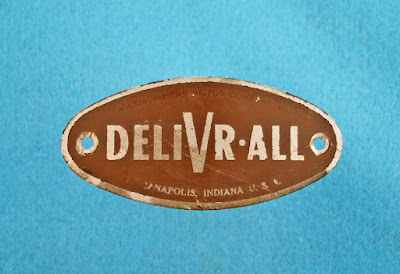Traylor Engineering & Manufacturing Co., Truck & Tractor Division (1920-1928)
Cornwells, Pennsylvania
 |
| This is a Traylor truck radiator emblem (c1920) moroz |
The Traylor Engineering & Manufacturing Company based in Allentown, Pennsylvania manufactured a number of industrial products and equipment. In 1920, the company also began to build motor trucks and farm tractors at a plant in Cornwells, Pennsylvania.
A Traylor advertisement from January 1920 lists the range of Traylor motor trucks as 1-ton, 1-1/2-ton, 2-1/2-ton and 3-1/2-ton capacity powered by four-cylinder Buda engines with three-speed and four-speed Brown-Lipe transmissions and Sheldon worm-drive rear axles.
Traylor motor truck advertisements in September 1921 offer a range of five truck sizes, 1-1/2-ton, 2-ton. 3-ton, 4-ton and 5-ton capacity. By March 1922, the range is stated as from 3/4-ton to 5-ton capacity. A 1-1/4-ton capacity Traylor truck is reported in 1924. Later references suggest a reduced range of trucks comprising 1-1/2-ton, 2-ton and 3-ton capacity from 1925 to the end of production in 1928.
The 1920's was a difficult time for small truck manufacturing companies. It is likely that Traylor motor truck sales were mainly local with limited overall truck production.
Emblems
There are very few original photos of Traylor trucks that clearly show the radiator in detail, although the radiator shape is clear, and none of the trucks seem to have survived.
However, Traylor truck advertisements include period photos of Traylor trucks and illustrations of the radiator tank top showing that Traylor trucks had cast metal radiators with the "TRAYLOR" name cast into the radiator tank top, as shown above at the top of this post.
Almost all Traylor truck advertisements include illustrations of the Traylor Logo, which depicts the letter "T" for Traylor passing through a keystone to represent Pennsylvania as the place where Traylor products were manufactured, see below:
 |
| This is the Traylor Logo |
The following Traylor truck advertisement from 1920 includes a photo of a Traylor truck, as well as illustrations of the Traylor truck radiator tank top and emblem and the Traylor logo:
 |
| Traylor truck advertisement (1920) americanikons |
The Traylor truck photo in this advertisement shows the heavy cast metal radiator tank top and radiator emblem, as well as a Traylor logo emblem, probably embossed and painted, on the radiator side panels, and a rectangular painted hood side Traylor nameplate, see detail shown below:
 |
| Traylor truck advertisement detail showing radiator emblems and hood side nameplate (1920) atj |
The rectangular hood side Traylor nameplate is more clearly seen in the illustration of a 2-1/2-ton truck on the following Traylor truck advertisement, which also shows the Traylor radiator tank top and a Traylor logo emblem mounted on the side of the driver's cab:
 |
| Traylor truck advertisement (1920) americanikons |
 |
| Traylor truck detail showing hood side nameplate and Traylor logo emblem by the driver's cab |
The Traylor truck hood side nameplate is also seen on the following blueprint drawing of a Traylor Model D 2-1/2-ton truck:
 |
| Traylor Model D 2-1/2-ton Truck showing hood side nameplate (c1920) |
Original Traylor hood side nameplates and Traylor logo body side emblems, if found, would be extremely rare.
The Traylor logo emblem also appears on a nameplate mounted on the front bumper of some heavy-duty Traylor trucks to form the word "FORTFYD" ("fortified"), see example below:
 |
| Traylor truck ad (1922) pittsburgh press |
 |
| Traylor truck detail showing the Traylor "T" logo on rad side & front bumper "FORTFYD" nameplate |
The following illustrations by Tad Burness show that the radiator side Traylor "T" logo and the "FOR
TFYD" front bumper nameplate were not used on the lighter-duty Trayor trucks:
 |
| Traylor 1-1/4-ton & 5-ton trucks (1924) tadburness |
The following painted, cast metal Traylor emblem is a quite different shape to the Traylor truck radiator emblems shown earlier and at the top of this post.
 |
This is a Traylor emblem (date uncertain) lktec
Size: 254mm wide 100mm high |
The shape of this emblem suggests a flat top radiator, if this was a radiator emblem, but I can find no evidence that any Traylor trucks had flat top radiators.
The Traylor Truck & Tractor Division also built Farm Tractors, as shown on the following Traylor advertisement:
 |
| Traylor ad showing Farm Tractor (1920) new york times |
However, the Traylor Farm Tractors had a circular radiator emblem, see photo below of a surviving Traylor Farm Tractor:
 |
| Traylor Farm Tractor Model 6-12 (1920) moroz |
The parent Traylor Engineering & Manufacturing Company of Allentown, Pennsylvania, which continued in business after closing down their Truck and Tractor Division in 1928, produced a variety of specialist equipment for the mining, milling, smelting and other process industries. Traylor catalogs for these products in the 1940s show a Traylor "trademark" or logo, which exactly resembles the unusual Traylor emblem design shown earlier, see example below:
 |
Traylor Process Industry Catalog (1945)
vintageadsandbooks |
It appears that the unusual cast metal Traylor emblem shown earlier above is from some piece of process industry equipment made by the Traylor company in the 1940s.









































